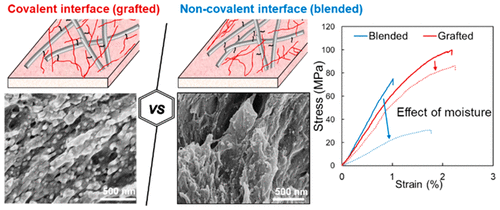当前位置:
X-MOL 学术
›
Biomacromolecules
›
论文详情
Our official English website, www.x-mol.net, welcomes your feedback! (Note: you will need to create a separate account there.)
Nanostructural Effects in High Cellulose Content Thermoplastic Nanocomposites with a Covalently Grafted Cellulose-Poly(methyl methacrylate) Interface.
Biomacromolecules ( IF 6.2 ) Pub Date : 2018-08-17 , DOI: 10.1021/acs.biomac.8b00701 Assya Boujemaoui 1 , Farhan Ansari 2 , Lars A Berglund 1, 3
Biomacromolecules ( IF 6.2 ) Pub Date : 2018-08-17 , DOI: 10.1021/acs.biomac.8b00701 Assya Boujemaoui 1 , Farhan Ansari 2 , Lars A Berglund 1, 3
Affiliation

|
A critical aspect in materials design of polymer nanocomposites is the nature of the nanoparticle/polymer interface. The present study investigates the effect of manipulation of the interface between cellulose nanofibrils (CNF) and poly(methyl methacrylate) (PMMA) on the optical, thermal, and mechanical properties of the corresponding nanocomposites. The CNF/PMMA interface is altered with a minimum of changes in material composition so that interface effects can be analyzed. The hydroxyl-rich surface of CNF fibrils is exploited to modify the CNF surface via an epoxide-hydroxyl reaction. CNF/PMMA nanocomposites are then prepared with high CNF content (∼38 wt %) using an approach where a porous CNF mat is impregnated with monomer or polymer. The nanocomposite interface is controlled by either providing PMMA grafts from the modified CNF surface or by solvent-assisted diffusion of PMMA into a CNF network (native and modified). The high content of CNF fibrils of ∼6 nm diameter leads to a strong interface and polymer matrix distribution effects. Moisture uptake and mechanical properties are measured at different relative humidity conditions. The nanocomposites with PMMA molecules grafted to cellulose exhibited much higher optical transparency, thermal stability, and hygro-mechanical properties than the control samples. The present modification and preparation strategies are versatile and may be used for cellulose nanocomposites of other compositions, architectures, properties, and functionalities.
中文翻译:

具有共价接枝纤维素-聚(甲基丙烯酸甲酯)界面的高纤维素含量热塑性纳米复合材料的纳米结构效应。
聚合物纳米复合材料的材料设计中的关键方面是纳米颗粒/聚合物界面的性质。本研究调查了纤维素纳米原纤维(CNF)和聚(甲基丙烯酸甲酯)(PMMA)之间的界面的操纵对相应的纳米复合材料的光学,热学和机械性能的影响。CNF / PMMA界面更改时,材料成分的变化很小,因此可以分析界面效应。利用CNF原纤维的富含羟基的表面通过环氧-羟基反应来修饰CNF表面。然后使用一种在多孔CNF毡中浸渍单体或聚合物的方法,制备具有高CNF含量(约38 wt%)的CNF / PMMA纳米复合材料。通过从改性的CNF表面提供PMMA接枝或通过溶剂辅助的PMMA扩散到CNF网络(天然和改性)中,可以控制纳米复合材料界面。直径约6 nm的高含量CNF原纤维导致强烈的界面和聚合物基体分布效应。在不同的相对湿度条件下测量水分吸收和机械性能。具有与纤维素接枝的PMMA分子的纳米复合材料比对照样品具有更高的光学透明性,热稳定性和吸湿机械性能。本发明的修饰和制备策略是通用的,并可用于其他组成,结构,性质和功能的纤维素纳米复合材料。直径约6 nm的高含量CNF原纤维导致很强的界面和聚合物基体分布效应。在不同的相对湿度条件下测量水分吸收和机械性能。具有与纤维素接枝的PMMA分子的纳米复合材料比对照样品具有更高的光学透明性,热稳定性和吸湿机械性能。本发明的修饰和制备策略是通用的,并可用于其他组成,结构,性质和功能的纤维素纳米复合材料。直径约6 nm的高含量CNF原纤维导致强烈的界面和聚合物基体分布效应。在不同的相对湿度条件下测量水分吸收和机械性能。具有与纤维素接枝的PMMA分子的纳米复合材料比对照样品具有更高的光学透明性,热稳定性和吸湿机械性能。本发明的修饰和制备策略是通用的,并可用于其他组成,结构,性质和功能的纤维素纳米复合材料。具有与纤维素接枝的PMMA分子的纳米复合材料比对照样品具有更高的光学透明性,热稳定性和吸湿机械性能。本发明的修饰和制备策略是通用的,并可用于其他组成,结构,性质和功能的纤维素纳米复合材料。具有与纤维素接枝的PMMA分子的纳米复合材料比对照样品具有更高的光学透明性,热稳定性和吸湿机械性能。本发明的修饰和制备策略是通用的,并可用于其他组成,结构,性质和功能的纤维素纳米复合材料。
更新日期:2018-07-26
中文翻译:

具有共价接枝纤维素-聚(甲基丙烯酸甲酯)界面的高纤维素含量热塑性纳米复合材料的纳米结构效应。
聚合物纳米复合材料的材料设计中的关键方面是纳米颗粒/聚合物界面的性质。本研究调查了纤维素纳米原纤维(CNF)和聚(甲基丙烯酸甲酯)(PMMA)之间的界面的操纵对相应的纳米复合材料的光学,热学和机械性能的影响。CNF / PMMA界面更改时,材料成分的变化很小,因此可以分析界面效应。利用CNF原纤维的富含羟基的表面通过环氧-羟基反应来修饰CNF表面。然后使用一种在多孔CNF毡中浸渍单体或聚合物的方法,制备具有高CNF含量(约38 wt%)的CNF / PMMA纳米复合材料。通过从改性的CNF表面提供PMMA接枝或通过溶剂辅助的PMMA扩散到CNF网络(天然和改性)中,可以控制纳米复合材料界面。直径约6 nm的高含量CNF原纤维导致强烈的界面和聚合物基体分布效应。在不同的相对湿度条件下测量水分吸收和机械性能。具有与纤维素接枝的PMMA分子的纳米复合材料比对照样品具有更高的光学透明性,热稳定性和吸湿机械性能。本发明的修饰和制备策略是通用的,并可用于其他组成,结构,性质和功能的纤维素纳米复合材料。直径约6 nm的高含量CNF原纤维导致很强的界面和聚合物基体分布效应。在不同的相对湿度条件下测量水分吸收和机械性能。具有与纤维素接枝的PMMA分子的纳米复合材料比对照样品具有更高的光学透明性,热稳定性和吸湿机械性能。本发明的修饰和制备策略是通用的,并可用于其他组成,结构,性质和功能的纤维素纳米复合材料。直径约6 nm的高含量CNF原纤维导致强烈的界面和聚合物基体分布效应。在不同的相对湿度条件下测量水分吸收和机械性能。具有与纤维素接枝的PMMA分子的纳米复合材料比对照样品具有更高的光学透明性,热稳定性和吸湿机械性能。本发明的修饰和制备策略是通用的,并可用于其他组成,结构,性质和功能的纤维素纳米复合材料。具有与纤维素接枝的PMMA分子的纳米复合材料比对照样品具有更高的光学透明性,热稳定性和吸湿机械性能。本发明的修饰和制备策略是通用的,并可用于其他组成,结构,性质和功能的纤维素纳米复合材料。具有与纤维素接枝的PMMA分子的纳米复合材料比对照样品具有更高的光学透明性,热稳定性和吸湿机械性能。本发明的修饰和制备策略是通用的,并可用于其他组成,结构,性质和功能的纤维素纳米复合材料。


























 京公网安备 11010802027423号
京公网安备 11010802027423号